
Issue #: 138
Published: November / December 2014
- Price per issue - digital : 5.40€Digital magazine
- Access to Multihulls World digital archives Digital archives
At the heart of the Pacific Ocean, the Society Islands offer sailors heading west a temporary return to the workings of French life overseas. In this regard, French Polynesia and the five archipelagoes of which it is comprised (the Gambier Islands, the Marquesas, the Tuamotus, the Austral Islands and the Society Islands) - each group very different from the other - remain a must on the round-the-world route. One thing is for sure: if you are used to sailing in the Atlantic, the real voyage begins in the Pacific… Here we continue to follow Olivier and his family’s cruise aboard Jaganda.
Barbara’s Diary:
“We set off from Opunohu Bay at sunset, bound for Huahine… It was still nice, with the wind blowing easterly force 3 to 4. As soon as we had cleared the pass, the swell was pushing us towards the west. Without being able to offer any proper explanation, at half a mile outside the pass and in several hundred meters of water, a single steep wave, several meters high, broke over Jaganda. Olivier just had time to warn us as he leapt to the helm. Our catamaran lifted way up on the port hull and suddenly we found ourselves horizontal. Hundreds of liters of water flowed across the deck, flooding the cockpit and coming into the salon. The rice-cooker made a sideways leap, but came back down in its spot. Dinner was saved! Later Olivier would tell us that evening on board Jaganda that we had experienced the biggest list of the whole trip! He confided in me afterwards that he was seriously concerned ahead of the very steep face of that wave which appeared out of nowhere.
In the early hours of June 29th, after a rough night at sea, we entered Huahine’s lagoon via the Avamoa Pass. We anchored off Faré, the island’s main village. I am particularly attached to Huahine. I’ve been lucky enough to stop here three times already, one of which was with the Taporo, the local supply ship which serves the islands, and carries passengers. Huahine is an island apart, different from her sisters: she has not been subjected to the same touristic developments, and so her originality remains intact. In 20 years I cannot see any major changes, and I’m glad of that. Huahine is comprised of two islands, linked by a narrow isthmus, enclosed within the same lagoon. The landscape is gentler than that of her neighbors, and her heavily indented coastline provides numerous anchorages. We make the most of being in Faré to revictual at a well-stocked Chinese store. There you can find everything: fresh goods, frozen, fruit, vegetables and “pai-bananes”, a stuffed pastry with banana jelly, which we all love on board.
We then set off for a very pretty anchorage on the west side of the island, at the entrance of Port Bourayne Bay. There, under the coconut trees, is a beautiful little white sand beach, where Marin enjoyed playing with his skimmer in the waves as they crashed on the bank. A wahine was watching, intrigued, and she told me that when she was young, she played in exactly the same way with a small wood board. This game is widespread among Polynesian children, and she was worried that it might eventually disappear…
In the lagoon south of Huahine, the serene island…
The day of our departure from Huahine, we stopped by Faré again to watch an amazing spectacle: the Va’a racing, outrigger canoes, dear to every Polynesian’s heart. Since we had arrived in Polynesia, not a day had gone by when we hadn't seen one or more tanés training in their pirogues. Their movement is supple and powerful, a rhythmic pace. A fascinating sight to watch, which for me remains one of the most beautiful images of Polynesia. The Va’a has become part of a real sports culture in these islands. Late in the afternoon, the pirogues set off out into the lagoon for marathon training sessions. The Va’a is most often seen with a crew of rowers who are truly choreographed, going from one side of the boat to the other with their only paddle at regular intervals, in the same perfectly synchronized movement. Off the village of Faré we saw ladies pirogue races, men’s races, solo and crews, all conducted with unstinting good humor. Lasting memories of a happy Polynesia…”
The Taporo VI, the supply ship which is the lifeline for these islands
So here we are, the star of the Pacific… For sure the landscape is powerful, majestic and perfectly proportioned. For sure its turquoise lagoon and motus fringed by white sand are a feast for the eyes. Bora Bora, it must be said, is a splendor. But I have to admit, it only just catches my heart. Bora Bora, the Pearl of the Pacific, is picture-postcard perfect. But it has become a celebrity island, where the rich come to find calm and luxury, and sensual pleasures. International tourists stay in luxury 5 star hotels, which are very (too) numerous (14 on the island and its motus!), and bungalows on stilts extend out over acres of turquoise water, invading the lagoon. Luxury shopping at over-inflated prices is all the rage. This hotel dynamic is largely artificial, as it is kept up by tax benefits not always in touch with economic market reality. The result of this is that none of the hotels are ever full, but apparently, the big international hotel chains can’t be seen to not have a hotel in Bora Bora’s lagoon… Of course this concentration of palaces poses an environmental problem. Even though the splendid colors of the lagoon are still there, the poor state of the bottom and the so-called “coral gardens” is heartbreaking to see. While going for a walk on the reef flats on the motus to the northeast of the lagoon, was that not an artificial hoa that we spied, a channel dug through the reef flat by a Caterpillar excavator, to allow more water from outside into the lagoon, to refresh the polluted water inside…? Bora Bora is in danger, whatever anyone says.
Va’a racing in the lagoon at Huahine. A thing of beauty…
As for anchorages in Bora Bora, you are spoilt for choice. Sailing in the lagoon is easy, because the navigational buoyage is of a high standard. To the west of the island, long motus, motu Ome, motu Tofari, motu Piti Aau line up one after the other. 4 luxury hotels are spread across them. We spent two or three days right at the southern end of motu Piti Aau, at Fareone Point. The color of the water there was spectacular. The children had fun in the most beautiful “coral garden” at Pointe Tupitipiti. After having climbed back up on the reef flat and gone a few hundred meters, the game consisted of letting themselves get taken by the current back to where they had started, while watching the marine flora and fauna, in the perfectly translucent water. You have to be careful though, not to get sliced open by the coral! The risk is very real. At the southeast of the island, motu Toopua also has some great anchorages, as well as Pointe Matira. The uninhabited motus are unfortunately often requisitioned by the hotels, for holding picnics and barbecues for their clients freshly disembarked from the Air Tahiti plane. Certain motus are also off limits because they are tabu (taboo)…
Maraamu! That’s the local name for the southeast wind which blows at this time of year in central Polynesia, which can sometimes break up the reefs. During our stay, it blew fairly strongly, pretty much continually (20 to 25 knots). By the end it was fiu! (tiring in Polynesian).
Enjoy the holidays in Polynesia!
Making the most (according to Olivier) of a slight northerly shift in the maraamu, which allowed us to go upwind (I love it!) on one tack towards Raiatea, we left Bora Bora. After a few hours of getting tossed around, we entered the lagoon of the Polynesian’s sacred island via the Toamaro Pass on the southwest of the island. We were pleased to find it calm, and after a recce by the children in the dinghy, we threaded our way through the coral heads to anchor at motu Nao Nao at the south of Raiatea. There was 20cm of water beneath our keels. It felt like the boat was sat on the sand. This anchorage is one of my top five in Polynesia. Perhaps that’s partly due to the fact that this area is preserved, unlike Bora Bora’s lagoon where the motus are under attack from hotel guests… Here the “coral gardens” really are gardens of coral: living things, colorful and with fish in abundance. Adélie and her friend Capucine undertook to chart the seabed around the boat. They set off with masks and fins for hours at a time to explore the lagoon, climbing back on board to draw charts and give names to the areas of coral, the underwater passages and the multicolored fish… I loved watching them be so inventive, so creative. Timothée and Marin spent hours hunting with spearguns. Olivier undertook kayak trips (always take a kayak on a catamaran!) close to the inside reef flats. As for me, I was swimming lengths alongside the motu’s immaculate beach. Only a black-tipped reef shark which got a bit too curious one day made me rejoin the captain on board his kayak…
Raiatea, the high island with a distinct landscape, is the main island of the Leeward Islands, well served by Air Tahiti airplanes and the supply “schooners”. Raiatea itself is a very natural island, which has been changed little, and is essentially agricultural. There are a few beaches, as well as those on the motus, and no significant hotel infrastructure. Mainly they are just family-run guest houses. The island is nicknamed “Raiatea the sacred” by the Polynesians because in former times it was the cultural, religious and historic center of the Society Islands. Its influence extended as far as New Zealand, and was part of the culture for the whole Maori population of the Pacific Islands.
Adélie, deckhand, in the blues of the Pearl of the Pacific’s lagoon.
Raiatea possesses the most well-known archeological site in the Leeward Islands, the marae Taputapuatea. This marae, located at the southeast of the island close to the village of Opoa is particularly well-kept. It gives a grandiose impression. Every new marae installed on neighboring islands had to incorporate a stone from marae Taputapuatea as a sign of allegiance, and to symbolize the spiritual lineage. I love Polynesian culture, unlike the children, who are left cold by the dark volcanic rocks of the marae! By contrast, a visit to a vanilla plantation captivated them. Olivier had met Odette Tauatiti at a vanilla exhibition in Papeete while we were in Tahiti. The captain had explained to her that we would be coming to Raiatea a few weeks later. Odette suggested to Olivier that we might like to visit the family plantation during our stay. So we called Odette, and arranged to meet the following morning. In the evening we anchored at Avera, on the east side of the island, where their agricultural business is located. In the morning, Guy, Odette’s husband, came to collect us in his 4x4, and took us to see the “ombrières” - the shades under which the vanilla vines grow, well-protected from birds, the sun and the rain. Growing vanilla, which is actually an orchid, is a delicate and fairly technical process. The “mariage de la vanille”, the fertilization process of the flower is carried out by hand, and requires an amount of dexterity. The successfully fertilized (90%) flowers transform slowly into several green pods. Nine months later the pods which have already turned brown are harvested, and then left carefully to dry for four to five months. They are then sorted, sized and packaged, before being shipped off to be sold in Papeete or exported. And that’s where the problem lies: in commercialization… No AOC label of quality for the moment, and a fairly unhelpful Polynesian government. Guy and Odette are helped by their son who lives in Papeete to find outlets for their local Polynesian produce. Their investment is considerable, climate change is disturbing the flowering, which is very late this year, and their returns are random. Guy and Odette are intelligent, enterprising, warm and welcoming Polynesians. They have learnt that they can count on no one but themselves to develop their family business.
The visit lasted all morning, and we had the opportunity to see all the stages of production - it’s really exciting! What mesmerizing fragrances around the drying racks in their garden next to the lagoon! Good luck to you, Guy and Odette. You deserve to be successful! (www.hotu-vanilla.pf)
The marae at Taputapuatea, a site where rituals were performed on sacred Raiatea.
The day continued with us walking the Three Falls trail. At this point, as usual, the children’s enthusiasm started to dwindle during the negotiation phase (the workings of our family are well documented…), but once on the trail, things were better. Over the years our little ones have become better walkers. This trail of around three hours started on the east coast. Giant bamboos, mapés (a tree with white wood, whose roots form little buttresses around the base of the trunk, and whose edible fruit resembles a chestnut), bracken and ginger make up a wonderful green landscape. Certain parts of the trail are equipped with a rope handrail. Arriving at the third waterfall is real reward. It measures sixty meters, and you can bathe in the pool. I love these days, where we discover the interior of an island and its riches. We also made the most of being in Raiatea, by going to Uturoa, the well-stocked main town on the island to get our supplies.
On July 25th we took our guests to Raiatea airport with a heavy heart. After five short weeks’ vacation on board Jaganda, the Air Tahiti plane took Timothée and Capucine back to Papeete. They set off the same evening for Paris… We got back on board in silence, sad. Tomorrow at daybreak we will reach Tahaa, before putting ourselves on stand-by in Bora Bora, waiting for favorable conditions to get through the narrow, and reportedly dangerous, pass into Maupiti…
The famous vanilla from the island of Raiatea.
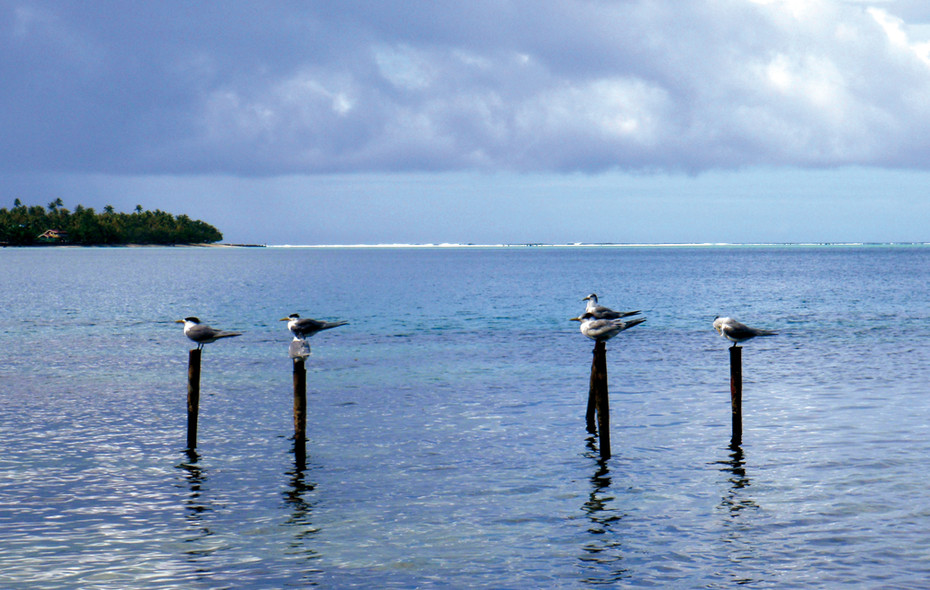
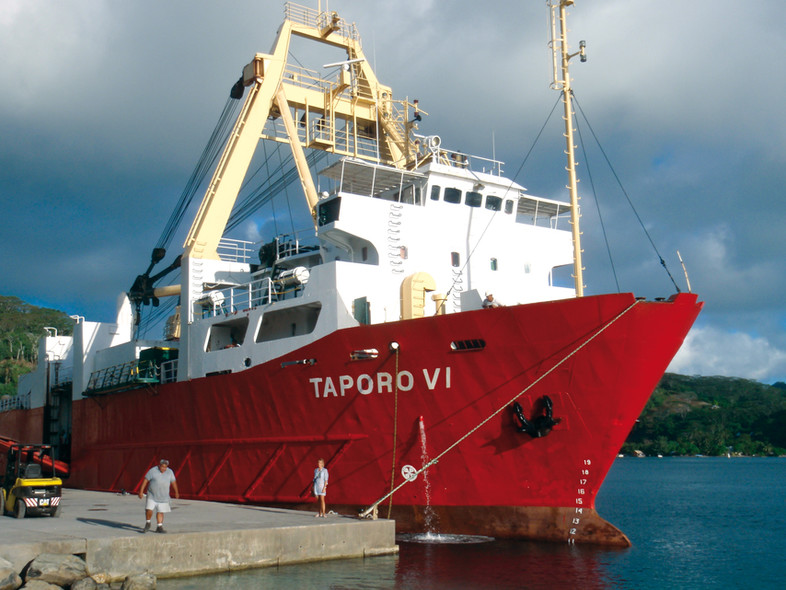

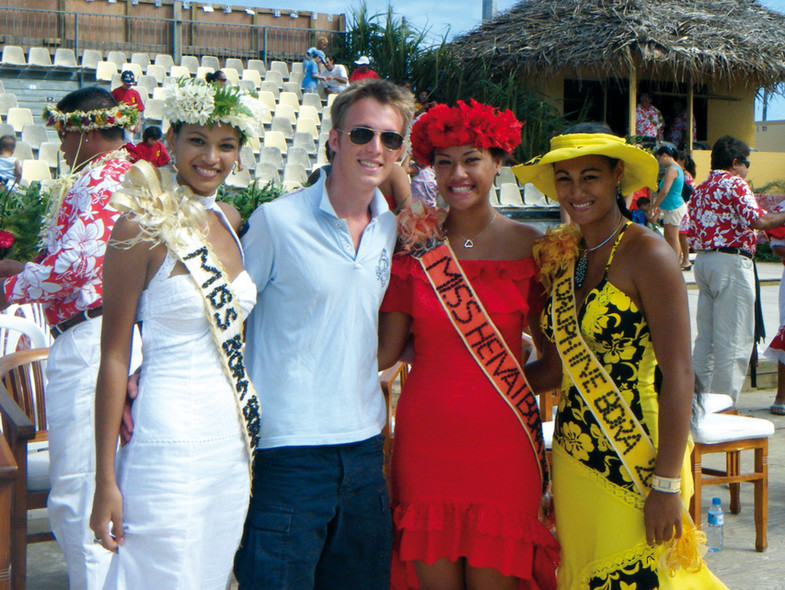
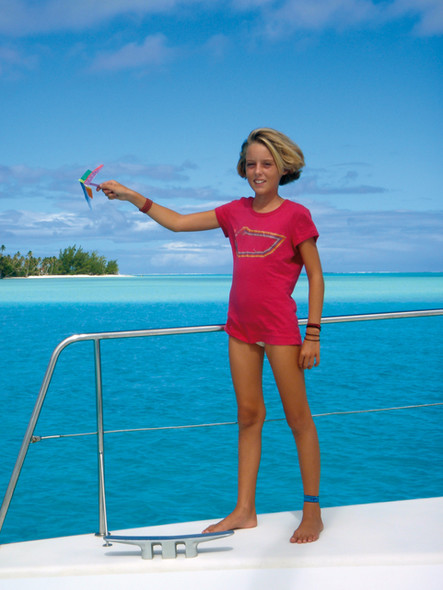
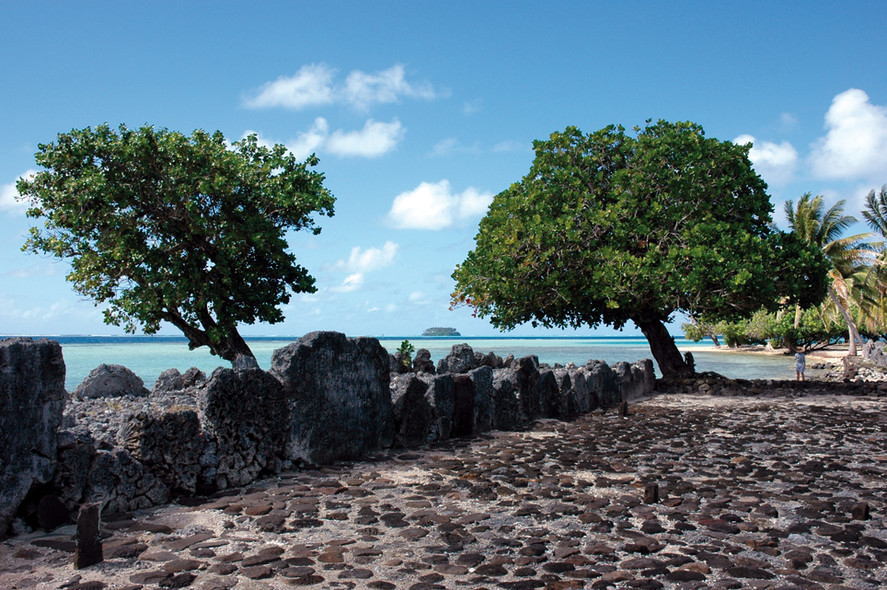
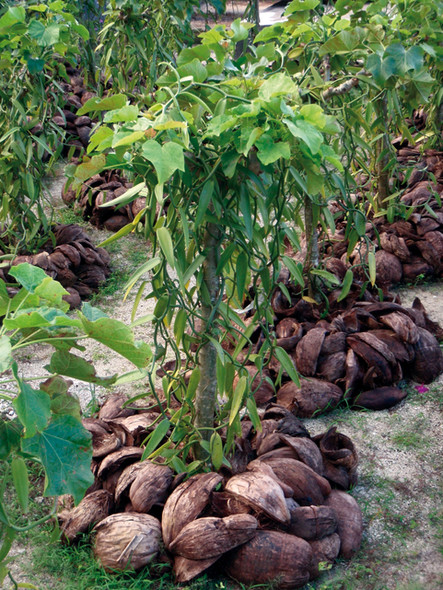
What readers think
Post a comment
No comments to show.